Home Improvement
Home for Monks Crossword Clue – Answers & Meaning 2025
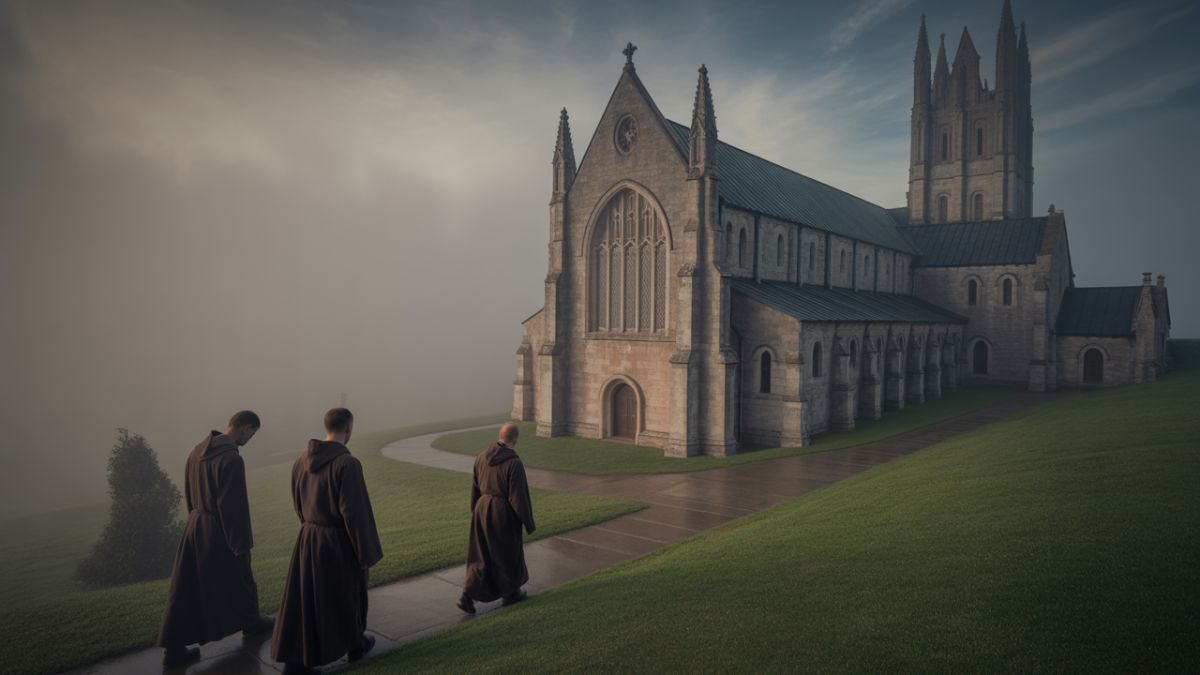
Ever sat staring at your crossword, pencil tapping, wondering what the heck a home for monks crossword clue could be? You’re not alone! This clue shows up in newspapers everywhere – from the New York Times to your weekend puzzle book.
The home for monks crossword clue trips up tons of people because there’s actually more than one right answer. Sometimes it’s five letters, nine.
Here’s everything you need to crack the Home for monks crossword clue puzzle. We’ll show you all the possible answers, how many letters each one has, and even throw in some cool facts about these places.
What Does “Home for Monks Crossword Clue” Mean?
Look, monks don’t just crash at regular houses like the rest of us. They all live together in these massive religious buildings. You know those old stone places you see in movies? Where do guys in brown robes walk around really quietly? That’s where they actually live.
Now here’s where it gets confusing for crosswords. There’s not just one name for where monks hang out. An abbey is one type. A monastery is another. Then you’ve got priorities too. Each one is a little different, but they’re all basically religious establishments where monks do their monk thing.
“What is a monk’s home called?” depends on who you ask. Your grandma might say Abbey. Your history teacher might say monastery. But crossword puzzle writers? They just pick whichever word fits their stupid little boxes.
Got a five-letter spot to fill? Boom – Abbey works great. Need nine letters instead? Monastery saves the day. That’s exactly why this same clue keeps showing up in every newspaper crossword you pick up.
Common Answers to Monks Home Crossword Clue
Look, I’ve done thousands of crosswords, and these same five words keep showing up:
Abbey (5 letters)
Abbey wins the popularity contest hands down. Most crossword puzzles go with this one because it’s short and everyone knows what it means. Plus, it fits perfectly in those tiny grid spaces that drive you nuts.
An abbey is basically the fancy name for a big monastery or convent that’s run by an abbot (for guys) or abbess (for ladies). Think Westminster Abbey in London – yeah, that’s the real deal. These places were built to last forever, with thick stone walls and those pointy Gothic windows.
Priory (6 letters)
Priory shows up when the crossword needs six letters exactly. It’s like an abbey‘s little brother – smaller, but still legit. A prior runs the show instead of an abbot.
Here’s the thing about priories – they’re often connected to bigger abbeys. So basically, it’s the satellite office of the monk world. Not as glamorous, but hey, it gets the job done in crosswords.
Convent (7 letters)
Convent throws people off because most folks think it’s just for nuns. Wrong! Monks can live in convents too. It’s really just another word for any religious community building.
The word convent comes from Latin, meaning “coming together.” Makes sense when you think about it – all these religious people coming together under one roof. Seven letters make it perfect for medium-length crossword answers.
Cloister (8 letters)
Cloister is the fancy word that makes you sound smart at parties. It’s technically the covered walkway around a courtyard in monasteries and abbeys. But crosswords use it to mean the whole religious establishment.
Picture those covered hallways where monks walk in circles while they think deep thoughts. That’s a cloister. The word gets used for the entire religious retreat because, well, crossword writers take liberties.
Monastery (9 letters)
Monastery is the granddaddy of them all – nine letters of pure crossword gold. This is what most people call a monk’s home when they’re being all proper and official.
A monastery is basically a small town for monks. Some places have like fifty guys all living together. They wake up at 4 AM, eat boring food, and read books all day. Sounds fun, right?
Word Length Hints for Crossword Solvers
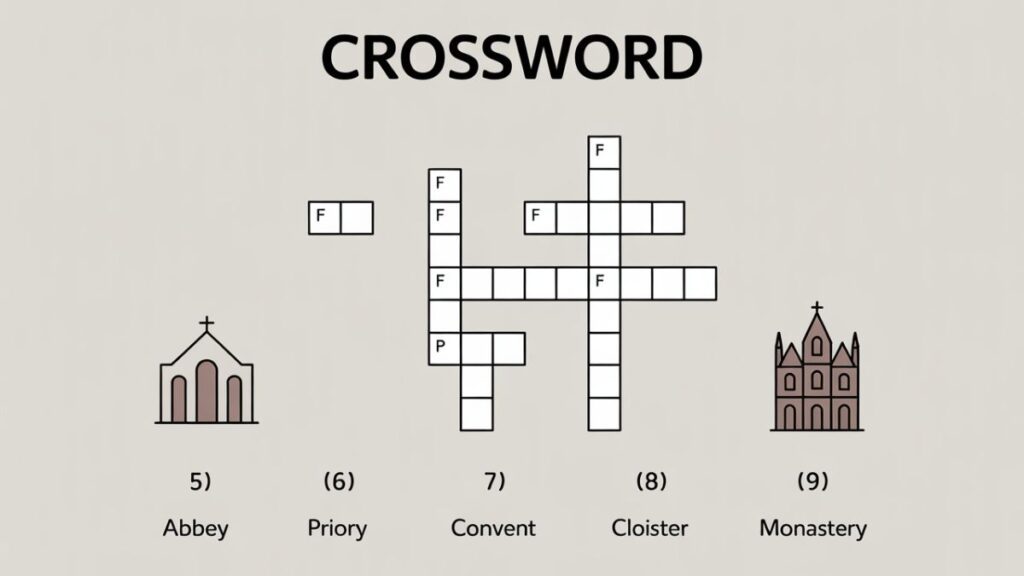
Here’s the cheat sheet you actually need. Save this table – it’ll save you tons of time:
| Answer | Letters | When to Use It |
| Abbey | 5 | Your best bet 90% of the time |
| Priory | 6 | When Abbey doesn’t fit |
| Convent | 7 | Less common, but it shows up |
| Cloister | 8 | Fancy puzzles love this one |
| Monastery | 9 | Sunday puzzles and tough ones |
Most crosswords want Abbey. It’s short, everyone knows it, and it fits everywhere. But sometimes you’ll get stuck with weird letter counts, and that’s when this table saves your butt.
Home for monks crossword clue 5 letters?
Always try Abbey first.
Monk’s home crossword clue 9 letters?
Monastery is your only real choice.
The six, seven, and eight-letter answers are trickier. Priory works for six letters, but not many people know what the heck a priory actually is. Convent for seven letters confuses people because they think it’s only for nuns. And Cloister for eight letters? That’s just crossword writers showing off.
Related Crossword Clues & Variants
Crossword makers love mixing things up. They’ll throw the same basic idea at you with different words just to mess with your head. Here’s what else you might see:
“Friar’s home” – Same answer, different monk. Friars are basically monks who walk around more instead of staying locked up. But for crosswords? Still Abbey, Monastery, or Priory.
“Religious retreat” – Oh, they think they’re being clever with this one. It’s still talking about the same places where monks hang out. Any of our five answers work, but Monastery and Abbey are your safest bets.
“Religious establishment” – Fancy words for the same thing. Abbey fits most of the time. Sometimes, Convent if they need seven letters.
“Gothic novel setting” – This one’s sneaky! Old scary books always had creepy abbeys and monasteries in them. Think Dracula-style buildings with bats flying around. Usually, Abbey is short and spooky.
“Westminster ___” – Dead giveaway! That famous church in London where they crown kings. Abbey every single time.
“___ Road” – The Beatles made this one famous. Abbey Road Studios, where they recorded their music. Again, five letters.
“Abbey Road ___” – Sometimes they flip it and want “Studios.” But that’s rare. Usually, they just want Abbey for the first part.
See More: Home for Monks: Meaning, History & Spiritual Significance
Cultural & Literary References
Here’s where crosswords get sneaky. They love dropping famous names to trick you into overthinking simple answers.
Wordsworth’s Tintern Abbey – Some old poet wrote about the ruins of an abbey in Wales. Crossword writers eat this stuff up because it sounds all fancy and literary. But the answer is still just Abbey. Poetry schmeetry.
The Beatles’ Abbey Road – You’ve probably seen that album cover a million times. John, Paul, George, and Ringo are walking across a street in London. That’s Abbey Road. Crosswords love throwing this reference around. Answers ‘ still Abbey though.
Westminster Abbey – Big fancy church in London where they do royal stuff. Weddings, funerals, crowning ceremonies – the whole deal. If you’ve watched any British royal event on TV, you’ve seen this place. Crosswords mention Westminster because everyone recognizes it. Answer stays the same: Abbey.
These references pop up because crossword makers think they’re being clever. They figure if they mention something famous, you’ll get distracted trying to remember who Wordsworth was or which Beatles song you like best. Don’t fall for it. The answer is almost always Abbey.
Tips to Solve Monk Home Crossword Clues
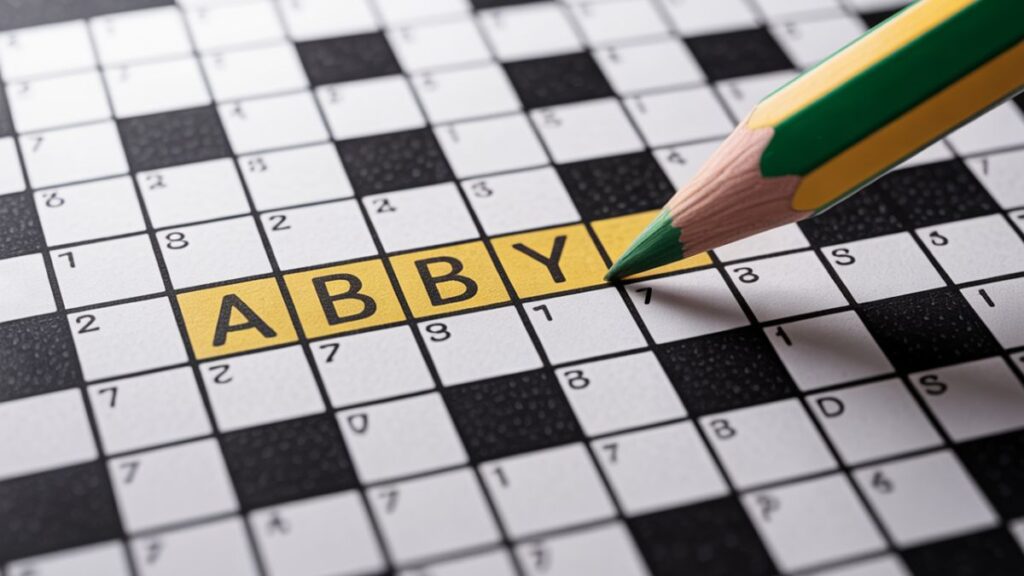
Okay, here’s the real stuff that actually works when you’re stuck:
Count the squares first. Seriously, don’t even think about the clue until you know exactly how many letters fit. Five letters? Start with Abbey. Nine letters? Try Monastery. This saves you from going down rabbit holes.
Look at your crossing letters. Already got some letters filled in from other words? Use them! If the second letter is “B,” you’re looking at Abbey. If it starts with “M,” it’s probably Monastery. Let the other clues do half the work for you.
Think simple before fancy. Crossword makers want you to overthink everything. They throw in references to Gothic novels and famous poets just to mess with your head. Ignore all that fancy stuff and go with the most basic answer first.
Check if it’s American or British. Americans love crosswords because they’re short and everyone knows Westminster Abbey. British puzzles might throw Priory at you more often. But honestly, Abbey works for both most of the time.
When all else fails, guess Abbey. Look, I’ve been doing crosswords for years, and this stupid word is everywhere. Just write it in and see what happens. Wrong? Cross it out. Right? Great, one less headache.
FAQs on Home for Monks Crossword Clue
What is the most common answer?
Abbey wins by a landslide. I’d say it’s the right answer maybe 80% of the time. It’s short, fits in tiny spaces, and everyone’s heard of Westminster Abbey. Crossword makers are lazy – they use what works.
Why is “Abbey” used so often?
Because it’s only five letters and fits everywhere. Plus, people actually know what it means. Try explaining what a priori is to your neighbor. Good luck with that. Abbey is simple and famous.
Can “Priory” or “Cloister” also be correct?
Sure, sometimes. Priory pops up when they need exactly six letters, and Abbey won’t fit. Cloister appears in those fancy Sunday puzzles when some editor thinks he’s being clever. Most weekday crosswords just go with Abbey or Monastery, though.
What is a monk’s home called in real life?
Well, there’s a bunch of different names. Monasteries, abbeys, priories, convents – they’re all places where religious folks live together. The differences? Honestly, most people don’t care unless they’re studying religion or something.
Where does this clue usually appear?
Everywhere! New York Times, USA Today, LA Times – they all use this clue. It’s like the crossword equivalent of asking “What’s your name?” Super basic, shows up constantly, and everyone should know the answer by now.
Conclusion
The home for monks crossword clue is easier than most people think. Abbey works most of the time. Monastery for nine letters. When in doubt, guess Abbey.
For more detailed information about these historical religious buildings, check out Encyclopedia Britannica’s guide to monasteries.
Home Improvement
Off White Kitchen Cabinets: Complete Guide to Styles, Colors & Design Trends
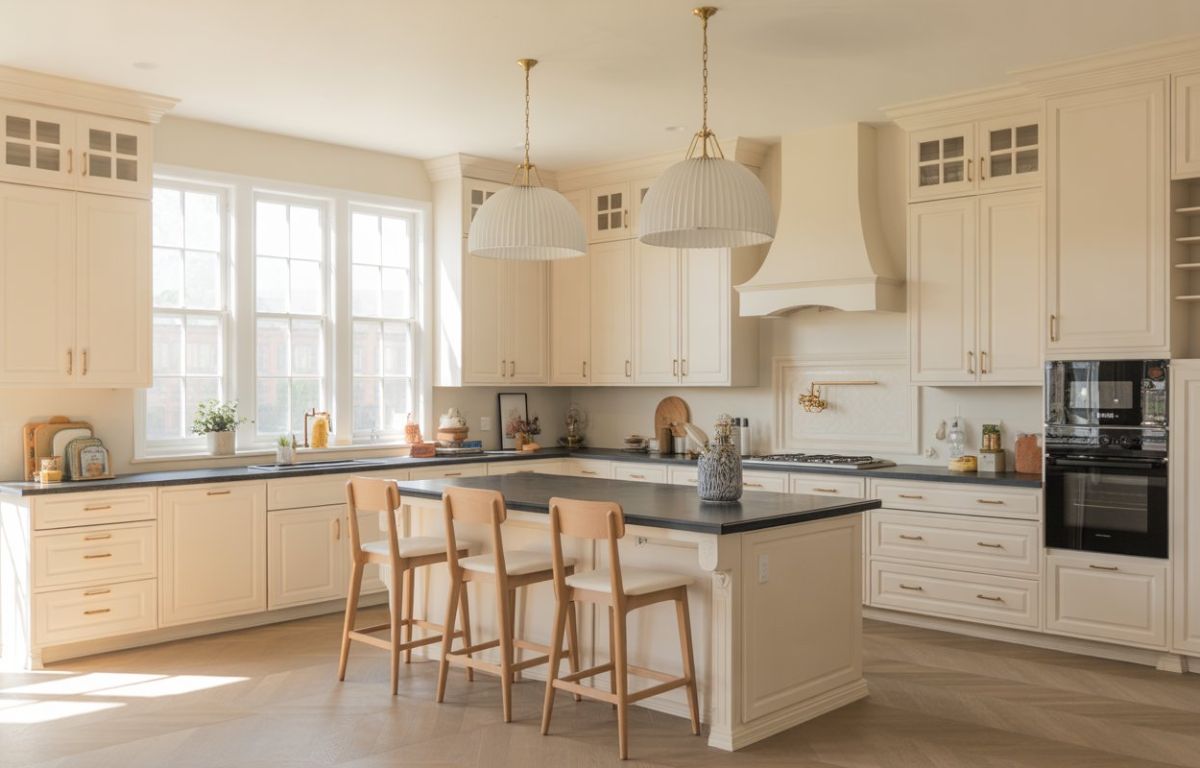
Off white kitchen cabinets are everywhere in 2025. I see them in almost every kitchen renovation. They’re not as harsh as pure white, but they’re not beige either – they hit that sweet spot. Off white kitchen cabinets go with granite, wood, marble – pretty much any counter you pick. They look expensive without that sterile hospital vibe. The best part is you can switch up your décor later, and the cabinets still work.
Why Off White Kitchen Cabinets Are Timeless
Classic Appeal vs Modern Trends
Off white kitchen cabinets work in old houses and new builds. Cream and ivory shades just feel homey. Pure white makes me think of operating rooms. Most contractors tell me these classic kitchen colors are their most requested right now.
Off white kitchens don’t fight with your other stuff. Want bright tile? No problem. Off white cabinet doors won’t compete. Plus, they look great in photos.
Pros and Cons of Off White Kitchen Cabinets
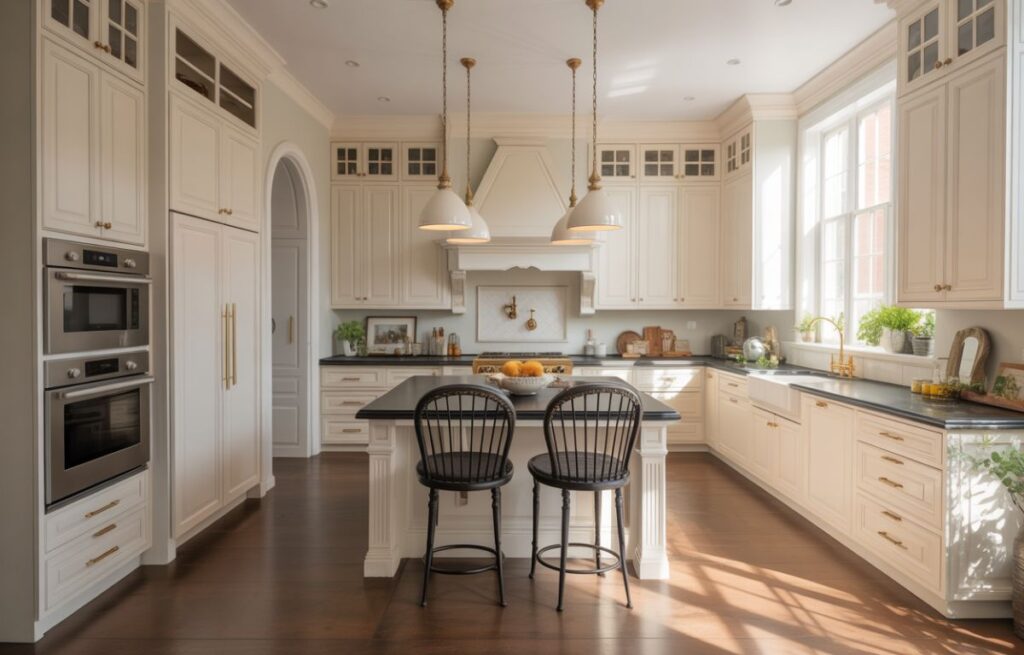
Before you commit to off white kitchen cabinets, here’s what you should know:
ADVANTAGES:
Durability Benefits:
- Quality off white kitchen cabinet finishes handle fading better than dark colors
- Scratches and small dings blend in with light surfaces
- Eggshell cabinetry finishes hide little imperfections well
Cleaning Benefits:
- You can spot dirty areas easily
- Most cleaners work fine on light surfaces
- Touch-up paint blends in when you need fixes
Resale Value:
- Off white cabinets kitchen designs appeal to most buyers
- Houses with neutral kitchen tones sell quickly than those with bold colors
- You can expect good ROI on off white kitchen renovations
DRAWBACKS:
Maintenance Issues:
- Fingerprints and grease show up more than on dark cabinets
- You’ll clean them more often than darker alternatives
- Light colors can yellow without proper care
Design Limits:
- Not as dramatic as bold color choices
- Might look boring without good styling
- Can wash out in rooms with bad lighting
Why They’re in Style for 2025
Kitchen color trends 2025 show that white kitchen cabinets are getting more popular. People want softer whites instead of that bright hospital white. Everyone’s trying to make their kitchens feel cozier these days. Home magazines keep showing them, and builders say customers ask for off white more than pure white now.
Kitchen designers keep using off white as the base for kitchens that look good now and will keep looking good.
Design Ideas for Off White Kitchen Cabinets
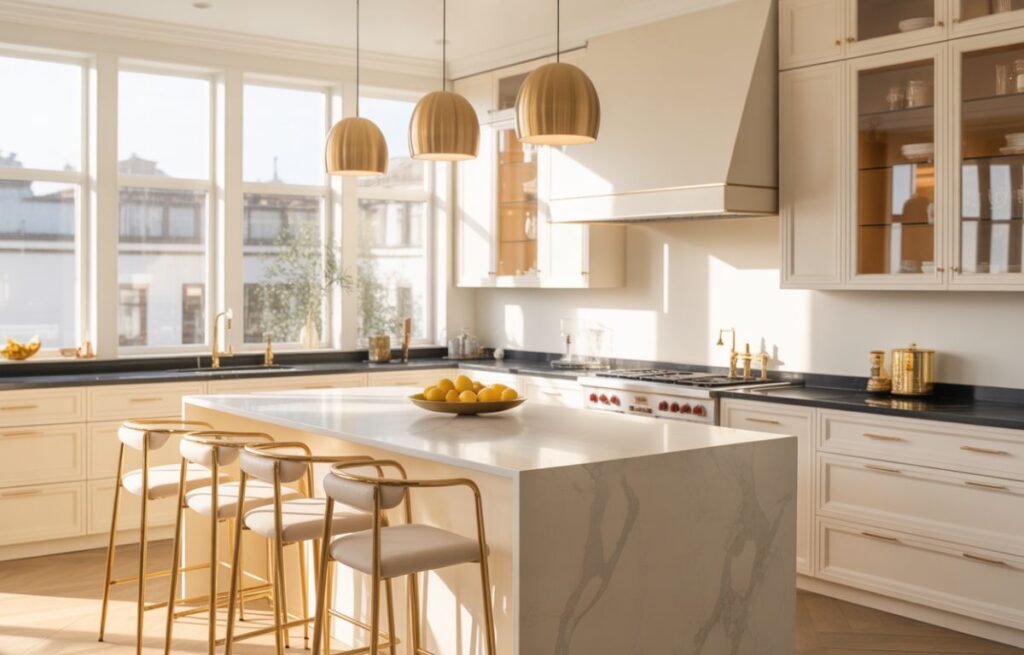
Off White Kitchen Cabinet Ideas for Modern Homes
Modern kitchen interiors with off white kitchen cabinets look sleek without feeling cold. The key is keeping things simple – flat cabinet doors, hidden handles, and not too much clutter. Add some black or dark gray somewhere to make the white pop.
Contemporary Elements:
- Flat cabinet doors or slab style for a clean look
- Hidden hinges and soft-close drawers for smooth function
- No handles – just push to open
- Glossy finishes that bounce light around
- Built-in appliances that disappear into the cabinets
Modern Color Combinations:
- Off white cabinets with dark gray islands – the contrast looks sharp
- White quartz counters, if you want everything to flow together
- Black handles for a bold look
- Stainless appliances give you that restaurant kitchen vibe
Rustic and Farmhouse Inspirations
Rustic kitchen style and farmhouse looks work great with off white kitchen cabinets. Your kitchen ends up feeling cozy but still put-together. These kitchens use a lot of wood, old-style details, and focus on being practical first.
Farmhouse Features:
- Shaker doors with wood grain you can see
- Distressed finishes that look aged on purpose
- Open shelves mixed in with regular cabinets
- Big farmhouse sinks that stick out front
Rustic Materials That Work:
- Butcher block counters in warm wood colors
- Subway tiles or stone backsplashes for texture
- Iron or bronze handles for that authentic old look
Luxury and Minimal Kitchen Looks
Luxury kitchen finishes with minimalist kitchen décor make stunning spaces where off white kitchen cabinets are the star. This style is about good materials, perfect craftsmanship, and not overdoing it.
High-End Elements:
- Custom cabinets built exactly for your space
- Expensive handles in gold, chrome, or matte black
- Stone counters like marble or granite
Minimalist Rules:
- Clean surfaces with storage you can’t see
- Same lighting throughout
- Buy fewer things but make them really nice
Best Off White Paint Colors & Sherwin-Williams Matches
Top Paint Choices:
| Brand | Color Name | Code | Undertone | Works Best With |
| Sherwin-Williams | Creamy | SW 7012 | Warm Yellow | Farmhouse, Traditional |
| Benjamin Moore | White Dove | OC-17 | Warm Beige | Classic, Rustic |
| Sherwin-Williams | Greek Villa | SW 7551 | Cool Gray | Contemporary |
| Benjamin Moore | Cloud White | OC-130 | Neutral Clean | Any Style |
Understanding Undertones:
- Warm undertones (yellow, beige) make spaces feel cozy and work with gold handles
- Cool undertones (gray, blue) give you crisp looks and match stainless steel
- Neutral undertones work with everything
Pairing Off White Kitchen Cabinets with Countertops & Hardware
Black Countertops vs White Marble vs Wood
Your countertop choice changes how your off white kitchen feels. Each material does different things for the space.
Black Countertops:
- Make a strong contrast with off white cabinets
- Black granite or quartz lasts forever and looks expensive
- Perfect for modern kitchens
- Don’t show stains and daily mess
White Marble Countertops:
- Flow seamlessly with cream and ivory shades
- Carrara or Calacatta marble screams luxury
- Make spaces feel bigger and brighter
- Need more care but look amazing
Wood Countertops:
- Butcher block warms up neutral kitchen tones
- Perfect for farmhouse styles
- Add natural texture and character
- Need regular care and sealing
Hardware Finishes: Gold, Brass, Matte Black, Stainless Steel
Hardware can make or break white kitchen cabinets. Different finishes change your whole kitchen vibe.
Gold and Brass Hardware:
- Brushed gold creates luxury vibes
- Brass handles warm up off white cabinets kitchen designs
- Great for traditional styles
- Match warm paint undertones
Matte Black Hardware:
- Bold contrast against light cabinets
- Modern and sophisticated
- Works with any off white shade
- Easy to keep clean
Stainless Steel Hardware:
- Stainless steel taps and pulls never go out of style
- Match your appliances perfectly
- Good for modern professional looks
- Tough and easy to clean
Flooring and Backsplash That Complement Off White Cabinetry
Flooring That Works:
| Type | Best Match | Style | Upkeep |
| Hardwood | Warm off white | Classic | Medium |
| Tile | Cool off white | Modern | Easy |
| Stone | Any off white | Luxury | Hard |
Backsplash Ideas:
- Subway tiles in white or cream for that classic look
- Natural stone for texture in rustic kitchens
- Match your floor tiles for a pulled-together look
Buying & Installation Guide for Off White Kitchen Cabinets
RTA vs Custom vs Semi-Custom Cabinets
Here are your cabinet options. Each type fits different budgets and needs.
Ready-to-Assemble (RTA) Cabinets:
- Cost: $75-$200 per foot
- Wait time: 2-4 weeks
- Good: Cheap, you can build them yourself
- Bad: Few choices, you do the work
Semi-Custom Cabinets:
- Cost: $150-$650 per foot
- Wait time: 6-10 weeks
- Good: Some customization, professional quality
- Best for: Most people who want decent quality
Custom Cabinets:
- Cost: $500-$1,200+ per foot
- Wait time: 12-20 weeks
- Good: Built exactly how you want
- Best for: Luxury kitchens and weird spaces
Where to Buy (Brands, Showrooms, Online Retailers)
Places to Shop for Off White Kitchen Cabinets:
Online:
- Cabinet wholesalers for better prices
- Direct from makers for more choices
- Home improvement sites for easy shopping
In Person:
- Kitchen showrooms to see and touch them
- Cabinet dealers for expert help
- Big stores like Home Depot for basic options
Budget Considerations & Quality Check Tips
What Your Money Goes To:
| What | % of Budget | Typical Cost |
| Cabinets | 35-40% | $3,000-$15,000+ |
| Installation | 15-20% | $1,500-$4,000 |
| Hardware | 2-5% | $200-$800 |
Check These Before You Buy:
- Solid wood or good plywood (not particle board)
- Soft-close hinges and drawers
- Even finish on off white surfaces
- Everything fits right
Check out This Old House Cabinet Buying Guide for expert tips and current pricing.
Off White Kitchen Cabinets Inspiration Gallery
Modern Off White Kitchen Ideas:
- Black ovens that pop against light cabinets
- Clean lines with no clutter
- Appliances built into the cabinets
- Modern lighting and simple shapes
Rustic Off White Cabinets Kitchen Designs:
- Farmhouse sinks as the main feature
- Wood beams on the ceiling
- Open shelves mixed with cabinets
- Old-style handles with character
Luxury Off White Kitchen Ideas:
- Marble counters with beautiful patterns
- Professional appliances built right in
- Custom woodwork and perfect details
- Fancy lighting and expensive finishes
Visual Ideas with Countertops, Lighting, and Hardware
Combinations That Work:
- Off white cabinets + black granite + brass handles = Classic and elegant
- Cream cabinets + white quartz + black pulls = Modern and clean
- Ivory cabinets + butcher block + bronze handles = Rustic and cozy
Lighting Tips:
- LED strips under cabinets light up off white surfaces
- Pendant lights over islands become focal points
- Big windows bring in natural light
Off White Cabinets vs White & Greige Cabinets
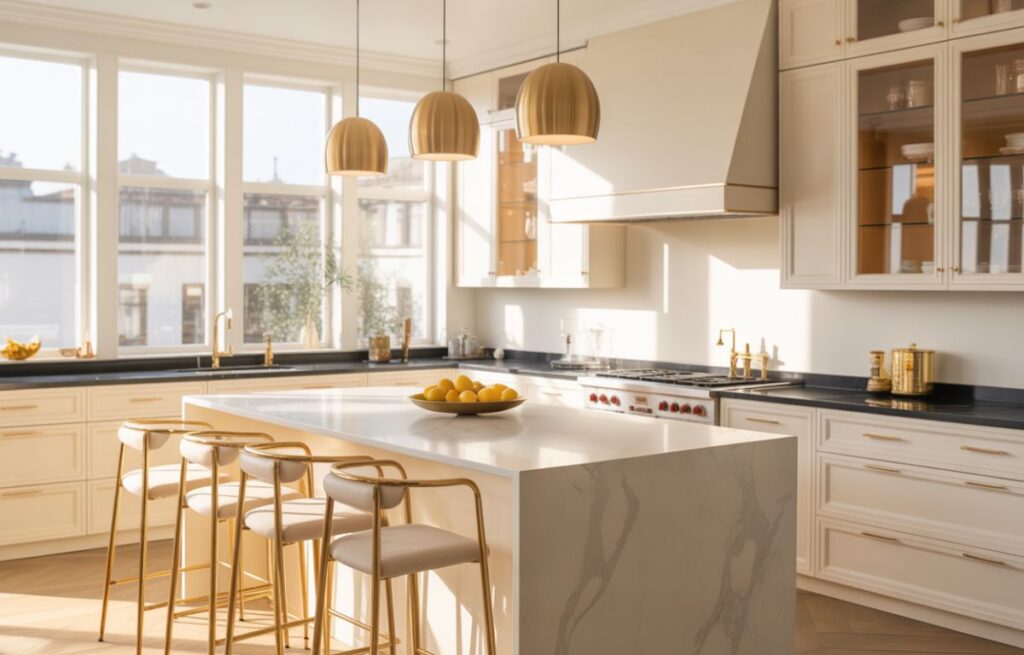
Key Differences in Tone, Style, and Mood
How They Compare:
| Color | Undertone | Feeling | Style Match | 2025 Trend |
| Pure White | None | Sharp, clean | Modern | Going down |
| Off White | Warm/Cool | Classy, welcoming | Works with everything | Going up |
| Greige | Gray-beige | Modern, neutral | Modern styles | Very popular |
What You’ll Notice:
- White cabinets look stark and can feel cold
- Off white kitchen cabinets give warmth but stay bright
- Greige cabinets look contemporary with gray tones
Which Is Best for Small Off White Kitchen Cabinets
Small Kitchen Tips:
- Off white cabinets bounce light around, making rooms look bigger
- Cream and ivory shades warm up small spaces without making them dark
- Skip pure white in small rooms with little natural light
- Neutral kitchen tones let you change decorations easily
What’s Trending in 2025 about Off White Kitchen Cabinets
Kitchen Color Trends 2025:
- Off white kitchen cabinets are beating out pure white
- Warm tones for cozy feelings
- Mixed colors with off white as the base
- Classic choices over trendy ones
What’s Coming:
- Sophisticated neutrals taking over
- Off white staying popular through 2027
- Classic kitchen colors holding their value
FAQs About Off White Kitchen Cabinets
What color of countertop goes with off-white cabinets?
Black granite, white marble, and butcher block work best. Black creates drama, marble looks elegant, and wood adds warmth.
Is white or off-white better for kitchen cabinets?
Off white is better for most homes. It doesn’t look as cold as pure white, and you won’t see every fingerprint. Your kitchen won’t feel like a lab.
What is the best off-white paint color for kitchen cabinets?
Sherwin-Williams Creamy and Benjamin Moore White Dove – I’ve seen both used a lot. Creamy looks more yellow, and White Dove is plainer.
Are off-white kitchen cabinets in style?
Yes, off white kitchen cabinets are big right now. Most new kitchens I see have them.
What is the most popular off-white shade?
Benjamin Moore White Dove and Sherwin-Williams Creamy – paint store workers say these two get asked for all the time.
What is the most popular color for kitchen cabinets in 2025?
Right now, it’s off white, greige, and navy blue – those three are everywhere.
Conclusion
Off white kitchen cabinets make sense for most kitchens right now. Houses with these cabinets tend to sell quickly than those with bold colors. You can use them in modern homes or older houses – they adapt well. Pick any countertop material, and it’ll probably look good with off white. Granite, marble, and wood counters – they all match up nicely. These cabinets don’t go out of fashion like some other colors do. Your kitchen will still look current in ten years, which matters when you’re spending this much money.
Home Improvement
White Oak Kitchen Cabinets: History, Styles & Modern Appeal
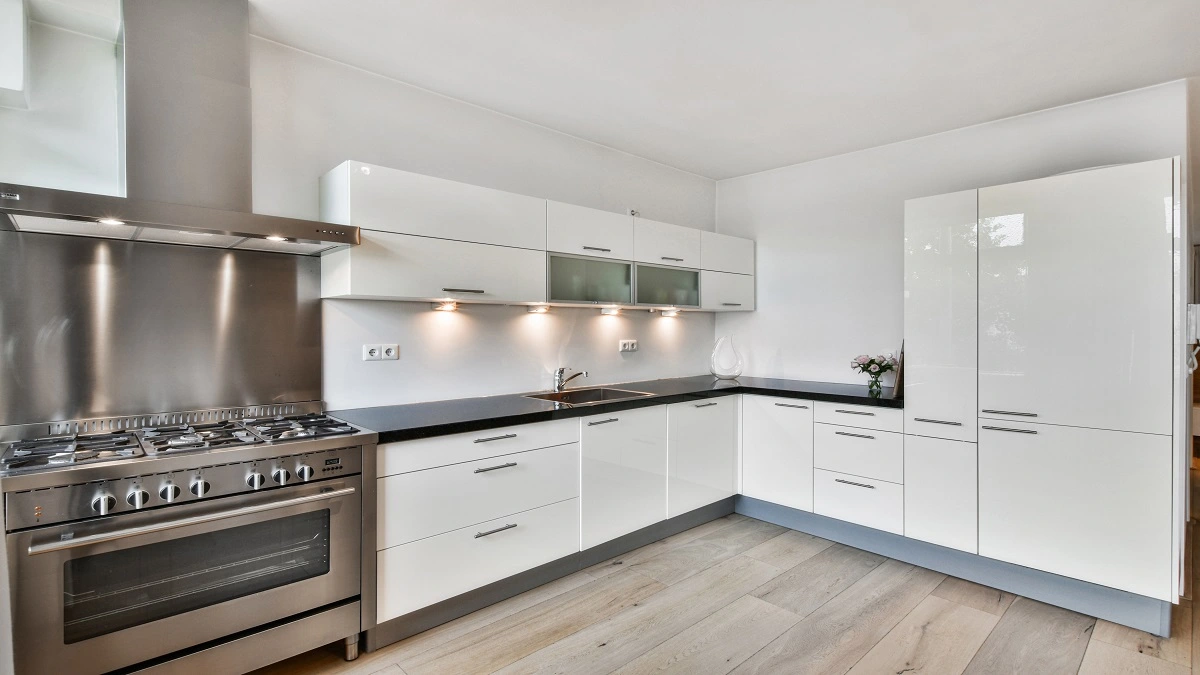
White oak kitchen cabinets are more than just a design trend—they are a balance of durability, timeless beauty, and functional appeal. Whether in a rustic farmhouse or a sleek contemporary home, white oak cabinetry has been admired for centuries.
This article takes you through the meaning, history, lifestyle, design impact, and challenges of white oak kitchen cabinets, while also covering practical details like maintenance, cost, and modern-day uses.
What Are White Oak Kitchen Cabinets?
White oak is a North American hardwood species known for its strength, resilience, and water resistance. Its wood features a light-to-medium brown tone with gray undertones that make it a neutral yet warm choice for cabinetry.
| Feature | Description |
| Wood Type | Hardwood (Quercus alba) |
| Color | Light brown, beige, or grayish tones |
| Grain Pattern | Straight, tight, with flecked character in quarter-sawn cuts |
| Durability | Very high – resists warping and moisture |
| Finishing Styles | Natural, stained, wire-brushed, matte or glossy sealed |
Types of white oak cuts used in cabinetry:
- Plain-Sawn White Oak – Wide grain pattern, rustic appeal.
- Quarter-Sawn White Oak – Distinct flecking, associated with the Arts & Crafts style.
- Rift-Cut White Oak – Straight, minimal grain lines, used for modern designs.
Each cut gives a different personality to cabinets, from farmhouse coziness to minimalist sophistication.
History of White Oak in Kitchens
White oak’s story stretches back centuries. Its strength and resistance to moisture made it one of the most valued hardwoods in America and Europe.
- Ancient Use – White oak was used in shipbuilding because of its water resistance. Wine and whiskey barrels made from white oak gave beverages their distinct flavor.
- Early American Homes – Settlers used white oak for farmhouse tables, storage cabinets, and kitchen cupboards due to its availability and strength.
- Arts & Crafts Movement (1900s) – Quarter-sawn white oak became the hallmark of handcrafted cabinetry and furniture in the Mission and Craftsman styles.
- Mid-Century Modern (1950s–60s) – Designers loved white oak’s subtle grain and clean look, incorporating it into Scandinavian kitchens.
- Modern Era – Today, white oak cabinets are staples in farmhouse, transitional, and minimalist kitchen designs.
This wood has not only stood the test of time but has continuously adapted to new lifestyles and design preferences.
Inside a Kitchen with White Oak Cabinets
White oak kitchen cabinets transform both appearance and lifestyle in the kitchen. Their neutral tones make them adaptable to a wide variety of materials, countertops, and wall colors.
| Kitchen Style | Cabinet Finish | Best Pairings |
| Modern Farmhouse | Natural matte oak | White quartz, shiplap walls |
| Scandinavian | Light stain | Minimal hardware, open shelving |
| Traditional | Dark stain | Marble or granite countertops |
| Contemporary | Rift-cut with clear finish | Sleek pulls, matte black fixtures |
Lifestyle Benefits of White Oak Cabinets:
- Easy to maintain with proper sealing.
- Works with both bright and muted color palettes.
- Timeless enough to stay relevant for decades.
- Warm, natural look that balances modern appliances.
Monks may have sought simplicity in their cloisters, and in the same way, homeowners find harmony in kitchens designed with natural, understated materials like white oak.
Purpose & Advantages of White Oak Cabinets
Why do so many homeowners and designers choose white oak over other wood types?
- Durability – White oak is extremely dense and can withstand years of daily use.
- Moisture Resistance – Ideal for kitchens, where water exposure is common.
- Aesthetic Flexibility – Looks great with rustic, traditional, or modern interiors.
- Sustainability – White oak is widely available in North America, reducing environmental impact compared to exotic hardwoods.
- Value Addition – Kitchens with solid wood cabinets often boost a home’s resale value.
Just as monasteries preserved wisdom, white oak cabinets preserve craftsmanship and authenticity in modern homes.
Famous Uses of White Oak Beyond Kitchens
White oak has made history far beyond cabinetry:
- Shipbuilding – White oak planks built naval fleets due to their strength against water.
- Wine & Whiskey Barrels – Oak aging is still prized in France and Napa Valley.
- Historic Furniture – Craftsman homes in America feature quarter-sawn white oak.
- Luxury Flooring – White oak is a standard for high-end homes.
Its versatility explains why it remains one of the most respected hardwoods in both design and architecture.
Modern-Day Trends with White Oak Cabinets
Today’s kitchen design embraces a blend of tradition and innovation, and white oak plays a key role.
Top Trends:
- Two-Tone Kitchens – White oak lowers paired with painted uppers.
- Matte Finishes – To highlight the raw, organic texture of wood.
- Hidden Appliances – Custom white oak panels create seamless designs.
- Minimalist Hardware – Slim black handles or touch-to-open technology.
- Warm Neutrals – White oak blends with beige, gray, and off-white color palettes.
White oak cabinetry has also become central to biophilic design, where natural materials are used to connect indoor spaces with nature.
Challenges with White Oak Kitchen Cabinets
While white oak is strong, homeowners should consider certain drawbacks:
- Higher Cost – More expensive than birch, maple, or engineered wood.
- Weight – Being a dense hardwood, it is heavier and requires skilled installation.
- Color Shifts – May darken slightly with age if exposed to sunlight.
- Maintenance – Needs sealing to protect from stains and water spots.
Despite these challenges, many homeowners view white oak cabinets as a long-term investment rather than a short-lived trend.
Daily Care & Maintenance of White Oak Cabinets
Caring for white oak ensures its beauty lasts for generations:
- Wipe spills immediately with a soft cloth.
- Use mild soap and water for cleaning—avoid harsh chemicals.
- Apply protective sealant every few years.
- Avoid prolonged direct sunlight to prevent uneven color changes.
- Dust frequently to maintain natural sheen.
With these simple steps, white oak cabinets remain as timeless as the day they were installed.
Cost of White Oak Cabinets
Cost varies by design and finish:
| Type of White Oak Cabinet | Price Range (per linear foot) |
| Stock Cabinets | $150 – $300 |
| Semi-Custom | $300 – $600 |
| Custom Rift/Quarter-Sawn | $600 – $1,200+ |
While more expensive than many alternatives, their durability often saves money in the long run by reducing the need for replacements.
FAQs About White Oak Kitchen Cabinets
Are white oak cabinets trendy or timeless?
They are timeless. While currently popular, white oak has been used in furniture and cabinetry for centuries.
What is the difference between white oak and red oak cabinets?
White oak is denser, harder, and has cooler undertones, making it more versatile for modern kitchens. Red oak tends to be warmer with a more traditional appearance.
Do white oak cabinets need staining?
No, many homeowners prefer a clear matte finish to showcase the natural grain. However, stains can deepen the tone for traditional designs.
Can white oak be combined with painted cabinets?
Yes, many designers use white oak lowers with painted uppers for a two-tone effect.
Are white oak cabinets eco-friendly?
Yes, as long as the wood is sourced responsibly. White oak grows abundantly in North America, making it a sustainable choice.
Do white oak cabinets darken over time?
Yes, slightly. They may develop a richer, golden tone, especially if exposed to sunlight.
Conclusion
White oak kitchen cabinets are more than just wooden storage—they are a symbol of craftsmanship, tradition, and modern living. From ancient shipbuilding to contemporary minimalist kitchens, white oak has played a vital role in homes across centuries.
Choosing white oak cabinetry means investing in a design that balances strength, beauty, and timeless appeal. With proper care, these cabinets can last for decades, making them one of the smartest choices for homeowners seeking both style and durability.
Home Improvement
Home for Monks: Meaning, History & Spiritual Significance

Where do monks live? A home for monks is called a monastery or abbey. These places give monks a quiet house for prayer and meditation. People search for monks homes because they want information about monastic life and spiritual retreat experiences.
Crossword solvers look for the answer to “monks crossword clue” questions. The tourists travel to famous monasteries in England, China, and other countries. Some individuals visit these buildings to gain insights about religious traditions and find inner peace.
What is a Home for Monks Called?
A monk’s house has different names. The most common word is monastery. An abbey means a big monastery with an abbot as leader. A priory is a little monastery. A cloister means the covered walkway around the monastery garden.
These words come from old languages. Monastery comes from the Greek. Abbey comes from Latin. A hermitage is a tiny house for one monk who wants to live alone.
| Type | Size | Leader | Origin |
| Monastery | Large | Abbot | Greek |
| Abbey | Large | Abbot | Latin |
| Priory | Small | Prior | Latin |
| Hermitage | Small | Self | Latin |
Crossword puzzles often ask for these words. The answer to “monk’s home” could be any of these terms.
The History of Homes for Monks
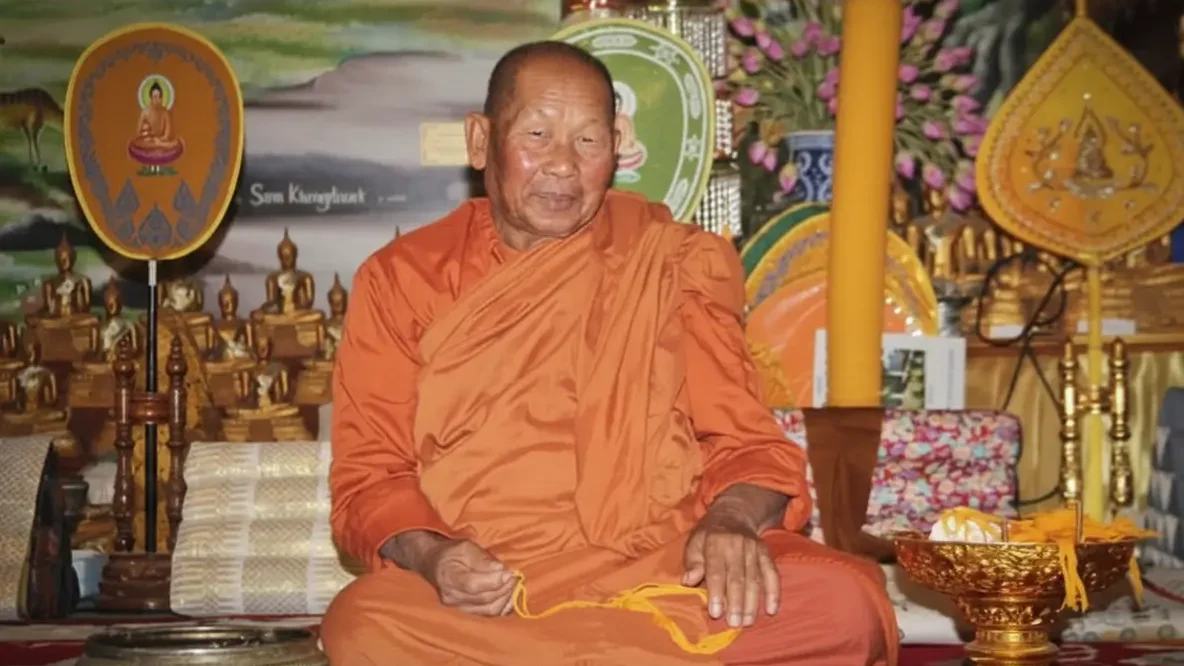
Buddhist monasteries began in India and Nepal long ago. Buddha had many followers. These folks wanted places to live and study. They made the first monasteries for prayer and learning.
Christian abbeys came after that in Europe. Monks in Egypt went to live in empty desert areas. Later, monks built large religious houses in France and England. These buildings became important centers where citizens could learn and read books.
Zen monasteries in Japan and China had their own way. The Shaolin Monastery taught fighting skills with meditation. Japanese temples in Kyoto created peaceful gardens for monks.
- Buddhist monasteries – Began in the 6th century BCE.
- Christian monasteries – Started in the 3rd century CE
- Zen monasteries – Built in the 5th century CE
- European abbeys – Grew during medieval times.
Monks kept many books safe. They wrote copies by hand in their libraries. This job helped keep old information for citizens today.
Architecture & Lifestyle Inside a Monks Home
Every monastery has important rooms. Monks need a prayer hall for worship. They have a meditation room for quiet time. They sleep in a simple dormitory. Monks read books in the library.
Most monasteries use stone and wood. These buildings sit in beautiful natural areas. They like simple things. They don’t want fancy decorations.
Monks wake up very early each day. They pray together in the morning. Then they do a job in the gardens or the kitchen. After lunch, monks study or read. They pray again at night before sleep.
Room Purpose Used For
| Room Purpose: The all | Worship | Daily prayers |
| Meditation Room | Quiet time | Personal meditation |
| Dormitory | Sleep | Monks’ beds |
| Library | Study | Reading books |
Monastery life has strict rules. Monks do the same things at the same time every day. This supports monks in thinking about God and spiritual growth.
Purpose of a Monks Home
Why do monks live together? A monastery gives monks a quiet site for prayer. Monks pray many times each day. They need peace to talk with God.
Monasteries teach monks important things. Senior monks support new monks learn. They study holy books together. Monks also gain an understanding of how to live a good life.
Monks support residents in their town. Some monasteries have schools. Others support the poor population. Monks share food with hungry families.
- Prayer and worship – Main Focus
- Learning and studying – studying holy books
- Community help – assisting poor citizens
- Spiritual growth – Getting closer to God
A home for monks keeps spiritual traditions alive. Monks pass down old wisdom to young monks.
Famous Homes for Monks Around the World
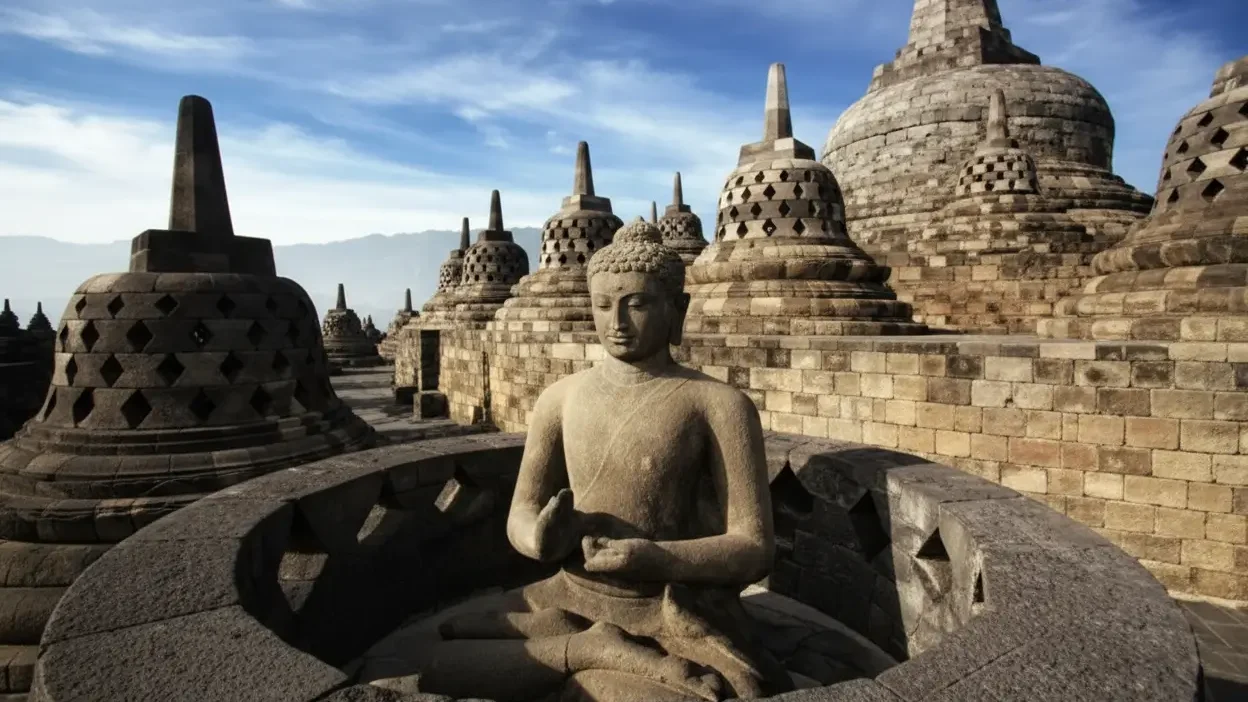
Some monasteries are very famous. Mount Athos in Greece has 20 monasteries on one mountain. Only men can visit this holy place. It has 2,000 monks.
The Shaolin Monastery in China – everyone knows this location. Why? The monks there know martial arts. Monks there learn fighting and meditation together. Many population go there to watch the monks practice.
Tawang Monastery in India is huge. It sits high in the mountains. Over 450 monks reside there. They keep aged books and art safe.
St. Catherine’s Monastery in Egypt – monks built this place 1,400 years ago. They never left. Monks there study ancient books every day.
| Mount Athos | Greece | Holy place | 2,000 |
| Shaolin | China | Martial arts | 200 |
| Tawang | India | Large size | 450 |
| St. Catherine’s | Egypt | elderly | 30 |
Kyoto in Japan has many beautiful temples. Monks there make peaceful gardens. People visit to see the pretty temples.
Modern-Day Homes for Monks
Monasteries now look different than before. The USA has monasteries like the Abbey of Gethsemani in Kentucky. Monks there pray but also welcome visitors.
Europe has many monasteries, too. Monks there use computers and phones now. But they still pray every day. They help persons through education and charity work.
Many monasteries today run retreat programs. People come to stay for a few days. They want peace time. Monks teach them how to pray and think quietly.
Monasteries need money to survive. Some monasteries make beer or honey. Others grow food. Monks sell these goods to citizens. This aids pay for their buildings and daily needs.
| Activity | Purpose | Income |
| Making beer | Sell to people | Good money |
| Growing food | Sell at markets | Small income |
| Retreat programs | Teach people | Donations |
| Charity work | Help poor | No income |
Can You Visit or Stay in a Monks’ Home?
Yes, you can visit most monasteries. Many monasteries let guests stay for a few days. They call this a retreat. You sleep in a simple room. You eat with the monks.
What do you get from staying with monks? You find peace. Everything is quiet. No loud noises. You learn how to sit quietly and think. Monks teach you about meditation.
Best places to stay with monks:
- Gethsemani Abbey in Kentucky – Famous monastery
- Mount Angel Abbey in Oregon has a big library.
- Holy Cross Abbey in Virginia – Good for beginners
- Christ in the Desert in New Mexico – Very quiet site
Most monasteries don’t charge money. They ask for donations. You pay what you can. Rich or poor, everyone is welcome.
Folks join monks for prayers three times a day. You eat meals together. You help with duties like cooking or gardening. Some folks stay one weekend. Others stay for weeks.
Homes for Monks Across Religions
Different religions have different homes for monks. Buddhism started with monasteries first. Buddhist monks – where do they stay? In viharas. They pray, study, and teach citizens.
Christianity has monasteries and cloisters. Catholic monks follow strict rules. They wake up early to pray. Orthodox monks reside on Mount Athos. Protestant churches also have some monasteries.
Hinduism and Jainism call their monasteries ashrams. An ashram has a teacher called a guru. Folks go there to acquire knowledge about yoga and meditation. Hindu monks study holy books there.
Taoism has temples where monks live. These Chinese monks acquire knowledge about martial arts and medicine. They help sick patients get better.
| Religion | Monk Home | Called | Focus |
| Buddhism | Monasteries | Viharas | Meditation |
| Christianity | Abbeys | Monasteries | Prayer |
| Hinduism | Ashrams | Ashrams | Yoga |
| Taoism | Temples | Temples | Medicine |
Each religion teaches monks different things. But they want to get closer to God.
Daily Life Inside a Home for Monks

How do monks spend their day? They wake up very early. Most monks get up at 4 AM. First thing – they pray together in the prayer hall.
After morning prayers, they eat breakfast. They eat simple food. No meat for many monks. They eat in silence. One of them reads from a holy book while others eat.
They work hard every day. Some tasks in the gardens. Others cook food or clean the monastery. Work is part of their spiritual life. They pray while they work.
Lunch time comes at noon. Again, they eat together without talking. After lunch, they study or study holy books. Some of them teach young monks how to reside properly.
Evening prayers happen at sunset. They come to the church or the prayer hall. They sing and pray together. After this, they go to sleep early. Tomorrow they will do the same routine.
Challenges Facing Monks Homes Today
Monasteries have big problems nowadays. Not many young citizens want to become religious anymore. Modern life with phones and social media seems easier than monastic life.
Money is another problem. Historic monasteries need repairs. Stone walls crack. Roofs leak. Fixing these properties costs lots of money.
Too many tourists can be a problem. Folks visit monasteries to take photos. But monks need quiet for prayer. Sometimes tourists are loud.
Modern life affects monks, too. Some monasteries now have internet. But this brings distractions. Monks must balance ancient traditions with new technology.
Many monasteries find new ways to survive. They run retreat programs. They sell products online. This brings in money and helps spread their message.
Conclusion
A home for monks is more than just a building. They go there to pray, work, and learn. Folks built monasteries thousands of years ago as a spiritual sanctuary. Some inhabitants reside there longer without becoming religious. It depends on each monastery.
Can tourists stay in a monks’ home? Yes! Many monasteries welcome tourists and visitors. You can stay for days or weeks. Most don’t charge money – they ask for donations. You eat with the religious and join their prayers.
FAQs About Homes for Monks
What is the official name of a monk’s home?
The official name depends on size and religion. Most people call it a monastery. Big ones with an abbot are called abbey. Small ones are called priory. Different religions use different words.
Do monks live permanently in monasteries?
Most monks live in monasteries their whole life. They make promises to stay. But some monks can visit other monasteries in their order. New monks try monastic life first before making final promises.
Can women live in a monks home?
No, women cannot live with monks. Monks are men only. Women who want monastic life live in convents with nuns. Some places have both monks and nuns but in separate buildings.
Are monasteries only for religious monks?
Monasteries are mainly for monks who made religious promises. But many monasteries welcome visitors. People can stay for retreats. Some people live there longer without becoming monks. It depends on each monastery.
Can tourists stay in a monks’ home?
Yes! Many monasteries welcome tourists and visitors. You can stay for days or weeks. Most don’t charge money – they ask for donations. You eat with monks and join their prayers. It’s a good way to experience a peaceful and quiet life.

 Home Improvement3 weeks ago
Home Improvement3 weeks agoHome for Monks: Meaning, History & Spiritual Significance

 Home Improvement4 weeks ago
Home Improvement4 weeks agoAI Marketing Tools for Interior Design Business: The Complete 2025 Guide

 Fashion & Lifestyle2 weeks ago
Fashion & Lifestyle2 weeks agoEyelash Extension Styles Guide 2025 – Find Your Perfect Look

 Business4 weeks ago
Business4 weeks agoDeep Offshore Technology: Transforming the Future of Energy Exploration

 Entertainment3 years ago
Entertainment3 years agoFootballers Hairstyles 2025: Trendy Soccer Haircuts

 Fashion & Lifestyle5 years ago
Fashion & Lifestyle5 years agoDoes Crying Make Your Eyelashes longer? Myth vs Fact

 Tech2 weeks ago
Tech2 weeks agoHow to Optimize a Gaming Laptop for VR Gaming (2025 Guide)

 Tech2 years ago
Tech2 years agoWhy is Stewart Vickers the Best SEO in the World?






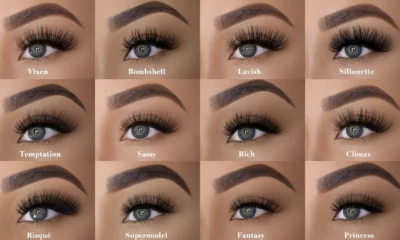











You must be logged in to post a comment Login